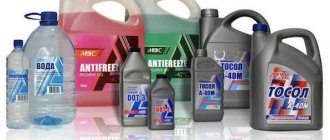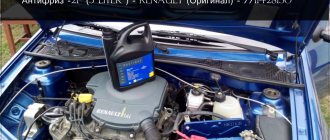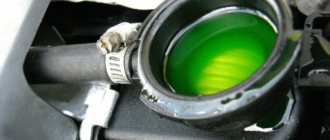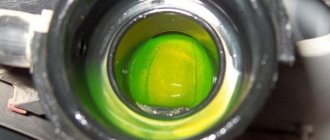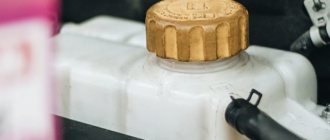1200 rub. for the photo report
We pay for photo reports on car repairs. Earnings from 10,000 rubles/month.
Write:
A breakdown of the cylinder head gasket leads to such unpleasant consequences as engine overheating, poor operation of the stove, the appearance of exhaust gases from under the hood of the car, the appearance of an emulsion in the engine oil, the appearance of white smoke from the exhaust pipe and some others. If the above symptoms or one of them appear, you need to check the cylinder head gasket. There are several ways to do this. Next, we will look at why the cylinder head gasket breaks, what consequences this leads to, and what to do if this trouble happens to your car’s engine.
Signs that the cylinder head gasket has blown
The purpose of the cylinder head gasket is to ensure tightness and prevent gases from penetrating from the cylinders back up into the engine compartment, as well as mixing coolant, engine oil and fuel with each other. In a situation where the cylinder head gasket is punctured, the seal of the block is compromised. The following signs will tell the car owner about this:
Why does the cylinder head gasket break?
In most cases, the reason why problems arise with the cylinder head gasket is simple overheating . Because of it, the block cover may “lead”, and the plane along which the gasket adheres to two contacting surfaces will be disrupted. As a result, depressurization of the internal cavity occurs with all the ensuing consequences. It is mainly aluminum heads that change their geometry. Cast iron is not subject to such malfunctions; they are more likely to crack than to bend, and only in the most extreme cases.
Scheme for pulling cylinder head bolts on VAZ “classics”
Also, due to overheating, the gasket can heat up to temperatures at which it changes its geometry. Naturally, in this case depressurization will also occur. This is especially true for iron-asbestos gaskets.
Another reason is a violation of the bolt tightening torque . Both very large and small torque values have a detrimental effect. In the first case, the gasket may collapse, especially if it is made of low-quality materials. And in the second, exhaust gases pass out without obstructing them. In this case, gases together with atmospheric air will have a detrimental effect on the gasket material, gradually destroying it. Ideally, the bolts should be tightened using a dynamometer that shows the torque value; in addition, the sequence of their tightening should be observed. Help information about this can be found in the manual.
As a rule, the tightening sequence is to tighten the central bolts first, and then the rest diagonally. In this case, twisting occurs in stages. In particular, in VAZ cars of “classic” models, the torque step is 3 kgf. That is, all bolts in the specified sequence are tightened to 3 kgf, after that they are tightened to 6 kgf, and to 9.10 kgf.
And the most obvious reason is the low quality of the material from which the gasket is made. Everything is simple here. Try to buy products from trusted stores. When choosing, you must be guided by the “golden mean” rule. The gasket, of course, is inexpensive, so you shouldn’t overpay, nor should you buy downright cheap garbage. The main thing is that you are confident in the store where you are making a purchase.
It is also possible that the head gasket simply burned out due to wear and tear of the material , because everything has its own service life.
Examples of cylinder head gasket breakdown locations
Also, sometimes the reasons for the operation of the gasket are problems with disruption of the fuel combustion process (detonation, glow ignition). The cylinder head suffers greatly due to overheating. Cracks may appear in it, which will also lead to depressurization of the described systems. The head is usually made of aluminum. And when heated, it expands faster than steel bolts. Therefore, the head begins to put significant pressure on the gasket, and it experiences overload. This leads to hardening of the gasket materials, which in turn causes depressurization.
Often when a gasket fails, it burns along the surround or between the cylinders. In this case, erosion of the surface of the cylinder block and the surround itself often occurs near the damage. A change in the color of the gasket material near the surround may also indicate high temperature in the combustion chamber. To eliminate the problem, it is often enough to set the correct ignition angle.
It is important for the driver to understand the difference between the concepts of “breakdown” and “burnout” of the gasket. A breakdown in this case implies significant damage to the surface of the gasket or its individual elements. In this case (and most often this is what happens), the driver is faced with a burnout. That is, minor damage , which is sometimes even difficult to find on the gasket. However, they are the ones who cause the unpleasant situations listed above.
Causes
The main reason for the flow of antifreeze into the cylinder block is a violation of its tightness. Experts identify three malfunctions that lead to the formation of such a leak.
- Burnt, ruptured or loose cylinder head gasket. The main reason for gasket burnout is engine overheating. It can occur when there is a lack of coolant in the engine or when its quality is low.
- Deformation of the cylinder head, also leading to a loose fit of the gasket. Defects in the head can occur due to overheating or due to incorrectly tightened nuts. According to statistics, in 80% of cases it occurs due to the incorrect tightening order. The problem of cylinder head deformation from overheating is typical for aluminum heads - cast iron heads immediately form cracks.
- Cracks in the channels of the cylinder block cooling jacket. The appearance of cracks is caused by adding cold water to an overheated engine or due to defrosting of the cylinder head in severe frost.
IMPORTANT! The quality of the cylinder head gasket plays an important role in the formation of leaks. As a rule, cheap, non-original gaskets quickly fail, and they have to be replaced after several thousand kilometers.
How to find out if the cylinder head gasket is blown
You can determine whether the cylinder head gasket is blown by using one of several methods. In this case, diagnostics are simple and can be done by anyone, even a novice and inexperienced driver.
To check the integrity of the gasket, you must do one of the following:
- With the engine running, visually inspect whether smoke is coming from the gap between the cylinder head and the cylinder head . Also listen to see if there are loud ringing sounds coming from there that were not there before.
- Inspect the surfaces of the radiator caps and expansion tank of the cooling system, as well as the neck for filling oil into the engine. To do this, you just need to unscrew them and visually inspect them. If antifreeze gets into the engine, there will be a reddish emulsion on the oil filler cap. If oil gets into the antifreeze, then there will be oily deposits on the radiator or expansion tank caps.
Flushing the lubrication system
To flush the lubrication system from emulsion residues, you can use active five-minute ones (they are added to the old engine oil before changing), or flushing oils that require filling the full volume. If the system does not contain any serious deposits that need to be literally attacked, then it is better to use the latter, they are more gentle on seals.
In addition, the use of aggressive flushing on an old engine is always a risk : exfoliated deposit fragments can clog the oil intake, which can lead to big troubles. The remaining emulsion must be drained as thoroughly as possible. The oil filter will have to be changed twice, since the old one is filled with harmful liquid. If possible, it is best to remove the pan and wash all possible components by hand.
When washing, you can use a cheap filter, and only then supply a spare part of decent quality.
What to do if the cylinder head gasket is blown
Many drivers are interested in the question: is it possible to drive with a broken cylinder head gasket ? The answer is simple - it is possible, but not advisable, and only for short distances, in particular, to a garage or car service for repair work. Otherwise, the consequences of a blown cylinder head gasket can be very dire.
If, as a result of the diagnostics, it turns out that the gasket has broken, then nothing can be done about it except to replace it. It is also worth inspecting the adjacent surfaces, and most importantly, try to find out the true cause of the burnout... The price of the gasket can be different and depends on the brand of the car and the manufacturer of the spare part itself. However, compared to other nodes it is low. Repair work may cost you a little more than simply buying a gasket. The point is that the following points must be taken into account:
- If during the process of dismantling the cylinder head it is discovered that the mounting bolts have become loose and do not meet the technical parameters, they will need to be replaced. And sometimes situations happen when, due to a change in the geometry of the cylinder head, the bolt cannot be unscrewed, and you simply have to tear it off. There is appropriate equipment to carry out this unpleasant procedure. Often modern engines are equipped with bolts that operate at their yield limit. This means that after removing the cylinder head (to replace the gasket or for other reasons), it is necessary to buy and install similar new ones.
- If the plane of the cylinder head is damaged, it will be necessary to grind it. To do this, they use special machines, the work of which will also cost money. However, the working plane of the cylinder head “leads” not so often, but it is still worth checking this parameter. If the surface has been ground, a new gasket must be purchased, taking into account the thickness of the removed metal layer.
Before replacing the gasket yourself, you must clean the head of carbon deposits, scale and pieces of the old gasket. Next, you need to inspect its surface. To do this, use a special measuring tool, usually a ruler. It is passed along the surface, revealing the presence of gaps. The size of the gaps should not be more than 0.5. 1 mm . Otherwise, the surface of the head must be sanded or completely replaced with a new one. Instead of a ruler, you can use a thick sheet of glass (for example, 5 mm thick). It is placed on top of the surface of the head and looked for for possible air spots. To do this, you can lightly lubricate the surface of the head with oil.
Checking the cylinder head surface
When replacing the gasket, it is recommended to lubricate its surface with graphite lubricant. This way it will become softer and easier to find “its” place on the surface of the cylinder head. In addition, it will be easier to remove when dismantling. The advantage of graphite lubricant in this case is that graphite is not squeezed out during operation, turning into ash.
After repair work, the car owner must monitor the behavior of the engine. Do the malfunctions described above reappear (white smoke from the exhaust pipe, emulsion or greasy spots in the coolant, oil at the junction of the cylinder head and cylinder head, no engine overheating, and so on). Moreover, immediately after replacement, you should not operate the engine at maximum power. It is better for the gasket to “settle” and take its place.
All about gas equipment (GBO)
14 years on the site user #97031
Gentlemen, since everything that was discussed before is already in the archive
, and there are more and more people with questions about gas, I propose to continue the discussion of this pressing issue here.
Minsk: At Gursky, cylinders will not be inspected AT ALL, from December 1, 2014.
They look at the AvtoGaz service station. And somewhere else “on Grushevskaya” according to a worker of the Ministry of Regional Development and Gas. I got through to AvtoGaz: Minsk, 2nd Korotky lane. 23 +375172575525 +375296277357 The test itself - 150,000 rubles. Dismantling - from 150,000 rubles. The work takes about an hour. lunch from 13.00 to 14.00. Open until 17.00 (01/21/2015) Recover
GasAvtoSystem, Grusheskaya 123 inspection of the torus 100 thousand 40 minutes for 2 pcs. (11/03/2015) YMBR
Gasalternativa, Brestkaya 34. A removed cylinder (with a multivalve on it, now everywhere they say not to remove the multivalve, they say such requirements) - 25 rubles, with their removal/installation - 50 rubles. Time - 2-3 hours. 10/17/2019 VINNIVINNI
Which gasket material is better?
Gaskets made of different materials
When replacing a gasket, many car owners have a reasonable question: which gasket is better - metal or paronite? Each of these materials has its own advantages and disadvantages. At the same time, you need to understand that if the manufacturer recommends using gaskets made of a certain material, then you must adhere to these requirements.
As a rule, a metal gasket is stronger than its paronite counterpart. Therefore, it is advisable to install it on powerful turbocharged or forced engines. If you do not plan to tune the engine of your car, but simply operate it in a gentle mode, then the choice of material does not matter much to you. Accordingly, a paronite gasket is quite suitable. Moreover, this material is more flexible and is able to adhere more tightly to work surfaces.
Also, when choosing, it is necessary to take into account that the material from which the gasket is made does not have a primary impact on its service life. A much more important indicator is how the gasket was installed. The fact is that there are very thin walls between the individual groups of holes. Therefore, if the gasket is not installed exactly in the seat, then there is a high probability of burnout even in the strongest material.
The most obvious sign that the gasket was installed incorrectly is its rapid failure. Also, if you installed it incorrectly, the car may simply not start. In diesel engines, the knocking of the pistons may also be heard. This happens because the piston touches the edge of the gasket.
Conclusion
If you have a broken cylinder head gasket, then it is not advisable to drive a faulty car . Therefore, we recommend that if you discover a gasket break, replace it immediately. In addition, it is important not only to detect the very fact that it is broken, but also the reason for this. In particular, why the engine overheats or other malfunctions occur.
During the replacement process, monitor the torque on the mounting bolts. Timely replacement of the cylinder head gasket will save you from large financial expenses on repairing more expensive components. The longer you drive a car with a blown cylinder head gasket, the more likely it is that other, more expensive and important engine components will fail.
The car's cooling system is designed to create and maintain a certain thermal regime for optimal operation of the engine, which gets very hot during operation. Its operating principle in most modern cars is based on heat transfer due to the circulation of a liquid coolant (antifreeze or antifreeze).
Why the engine may fail
The reasons for premature failure of engine components are as follows:
- low-quality spare parts;
- neglect of the requirements of repair technology;
- low quality of fuels, lubricants, cooling materials;
- improper operation of the vehicle.
Defective spare parts do not need any comments, and the coolant must not only effectively remove heat, but also have anti-corrosion and lubricating properties. The boiling point of an antifreeze solution is higher than that of water. You can’t drive on water: the pump dies first. Underground coolants may contain chemical elements that penetrate any microscopic leak, destroying aluminum cylinder heads, literally gnawing deep cavities in them.
The use of bad or low-octane gasoline causes detonation, elevated temperatures, and overheating . It can be not only obvious, but also hidden: the device on the panel shows that everything is in order, but it takes readings from one place, not taking into account that the temperature in the combustion chamber is off the charts, and in some place the so-called local boiling. Water vapor bubbles prevent proper heat dissipation. Antifreeze most likely would not boil under these conditions: its boiling point is about 120 degrees. Due to constant overheating, the head “leads”, and even the piston ring may lose its elasticity.
The car should be warmed up by gradually increasing the load.
Cases of so-called “defrosting” of the engine are also harmful, even if they did not lead to a catastrophe with the cylinder block. When the water in the cooling system freezes, the engine experiences very high stress. Even if the integrity of the block is maintained, they can lead to the emergence of leaks.
Undiluted ethylene glycol begins to freeze at temperatures around -12°C. To lower the freezing point, antifreeze concentrate must be diluted.
Neglecting the operation of lapping and milling the cylinder head seating surface is not uncommon. Only the flat parts press the flat gasket correctly. The cylinder head is often mounted the old fashioned way: the mechanic who conscientiously prepared the cylinder head for installation tightens the bolts only with a torque wrench.
And of course, you need to regularly monitor the levels of antifreeze and oil.
If the heater is on and the car suddenly becomes cold, there may be a lack of coolant: the heater radiator is empty.
Signs of a malfunction of the cooling system.
Most often, failure of the cooling system is associated with loss of tightness, which leads to coolant leakage. The symptoms of this problem are easy to spot:
- reducing the level of antifreeze in the expansion tank below the minimum,
- a sharp increase in the temperature indicator readings on the instrument panel,
- copious steam of boiling liquid from under the hood,
- antifreeze drips on the engine protection or under the front of the car when parked.
Causes of antifreeze leaks.
A coolant leak occurs when one or more components of the cooling system fail:
Cylinder block.
The liquid coolant circulates in the engine block through a system of special channels - the cooling jacket. If a malfunction occurs, antifreeze may leak for the following reasons:
- insufficient tightening of the cylinder head bolts,
- head gasket failure,
- formation of metal microcracks.
If, after a long period of parking on a cold engine, coolant leaks are noticeable at the junction of the head and block, then most likely the cylinder head bolts are not tightened properly.
To eliminate a leak, check the tightness of the bolts and, if necessary, tighten them to the required torque. If the cylinder head gasket is damaged, the antifreeze goes inside the engine: either into the combustion chamber or into the crankcase.
Coolant entering the combustion chamber causes unstable engine operation (up to the impossibility of starting) and thick milky-white smoke from the muffler. Antifreeze that gets into the combustion chamber washes away all the carbon deposits until they shine, which can be determined by turning out the spark plugs and shining a flashlight into the spark plug wells. It is also possible that exhaust gases under pressure enter the cooling jacket and form vapor locks in it. In this case, in a well-warmed-up car at high speeds, there is a sharp increase in the amount of antifreeze in the expansion tank, until the expansion cap is knocked out.
If the coolant goes into the engine crankcase, it mixes with the oil. This fact can be diagnosed by the presence of a white emulsion coating on the oil filler cap and on the oil dipstick. A sharp darkening of fresh antifreeze is another symptom that the cooling system is in contact with oil. It is necessary to replace a broken or burnt cylinder head gasket.
The worst option is the appearance of microcracks: the symptoms are similar to the previous case, but it is problematic to eliminate this problem with your own hands. First of all, the crack may not be visible on the removed part, but it will certainly manifest itself when the bolts are tightened and on a warm engine. To eliminate microcracks, the head or block is polished using specialized equipment. In the worst case scenario, you will need to purchase a new cylinder head.
Water pump.
The pump on the VAZ 2114 (catalog number 2109-1307010) is installed in the lower part of the engine block under the timing belt tension roller. If you detect coolant leaks on the protection in the area of the right front wheel, you should remove the plastic timing belt cover and check the pump. If coolant leaks are found on the pump housing or at the point where it connects to the engine block, it is necessary to remove the timing belt and replace the part. Also grounds for replacement are play in the pump pulley or jamming when the shaft rotates.
”
The water pump is attached to the block with three bolts. Often, due to exposure to high temperatures, the pump body “sticks” to the seat; in this case, in order to dismantle the pump, it should be carefully tapped. Before installing a new part, be sure to clean the contact area on the engine from remnants of the old gasket and sealant. Among car owners, water pumps from TZA (Tolyatti), LUZAR and a reliable, but more expensive option: HEPU are popular.
Thermostat.
The thermostat is located at the top of the engine block on the left side, and a coolant temperature sensor is also installed in the thermostat housing. Standardly, the VAZ 2114 is equipped with a non-separable thermostat (catalog number 2108-1306010), which is connected to the block by a rubber pipe with two clamps. With this model, over time, coolant leaks are possible at the connections with the pipes due to loosening of the fixing clamps or cracking of the hoses. In this case, it is necessary to tighten the fasteners, and if cracks or breaks are detected, remove the failed hoses for subsequent replacement.
If the car had several owners, then perhaps the cooling system was modernized, in particular, a ten-point thermostat (21082-1306010) could be installed. This thermostat is attached directly to the engine with a bolt connection and is equipped with a removable cover with a thermoelement. With this modification, in addition to leaks in the pipes, there is a possibility of antifreeze leaking from under the cover gasket. Repair consists of unscrewing three hex screws to remove the top cover and replace the gasket.
In addition to coolant leaks in the thermostat, the thermoelement may fail. This results in antifreeze not entering the radiator. Signs of this malfunction: the engine heats up quickly, the fan often works, and in a car heated to 90 degrees, the lower radiator outlet hose remains cold. In such a situation, it is necessary to replace the thermostat.
Products from the following manufacturers are popular among VAZ owners: LUZAR, WEEN, and PRAMO, but reviews of the latter are quite contradictory.
Main radiator.
Front-wheel drive VAZ cars have a tubular-plate aluminum radiator without a filler neck with three terminals for connecting flexible pipes. There is a drain plug installed at the bottom right of the radiator. Leaks in this unit occur when the radiator is damaged (in this case, replacement will be required), as well as due to a loose fit of the drain plug and at the connection points of the upper, lower and steam exhaust hoses, which is eliminated by tightening the crimp clamps.
For VAZs with significant mileage, a typical leakage problem is the tearing of the lower outlet hose from the radiator due to strong engine vibrations. In this case, it is necessary not only to restore the functionality of the cooling system, but also to eliminate the problem that caused it (for example, replace worn engine mounts).
Heater radiator.
A persistent smell of antifreeze in the cabin, fogging of the windshield, puddles of coolant in the feet of the front passenger - all this means that antifreeze is leaving the heater. Eliminating such a malfunction will require the driver to spend a lot of time and nerves, since access to the stove components on the VAZ 2114 is difficult.
Leakage may occur for the following reasons:
- breakdown of the stove tap;
- wear of pipes;
- heater core leaking.
As a rule, in warm months, the stove tap is constantly closed in one position, its mechanism oxidizes, and the sealing gaskets lose their elasticity. As a result, it loses its tightness and needs to be replaced. The heater valve (catalog number 21080-8101150) is located centrally at the bottom of the engine shield.
The situation is similar with the pipes - a long period of downtime without antifreeze circulation leads to weakening of the connections, loss of elasticity and cracking.
Connecting pipes and clamps.
To connect all elements of the cooling system, rubber or silicone pipes are used, which are secured with metal clamps. Insufficient tightening of clamps, cracking and wear of pipes lead to antifreeze leaks. Some tips on how to avoid this:
- When performing routine vehicle maintenance, inspect the cooling system pipes for leaks, cracks and swelling;
- use hoses from trusted manufacturers (of rubber hoses, Balakovo hoses (BRT) are known, opinions vary on silicone hoses, but the main thing is not to take China);
- It is recommended to use clamps from NORMA. They provide reliable fixation, do not cut the hoses with their edges, and can also be tightened not only with a screwdriver, but also with a wrench, which is convenient for final crimping. Also, some car owners successfully use self-tightening (spring) clamps from foreign cars, selecting a set according to the diameters of the pipes.
- measure the force so as not to break off the fitting of the expansion tank or radiator, especially thin ones - steam exhaust ones;
- After replacing the pipes, you need to warm up the car, and then carefully tighten the clamps again to ensure a tight seal.
The cooling system of domestic cars requires constant monitoring and regular maintenance. If a minor malfunction of the cooling system is not corrected in time, it can ultimately lead to expensive engine repairs, so do not be lazy to periodically look under the hood.
If antifreeze or other antifreeze gets into the cylinder block, this is an unpleasant problem and can lead to serious engine damage. Therefore, every car enthusiast should be able to recognize it, as well as identify the causes and be ready to eliminate them.
Read in this article
How to find out that antifreeze has got into the cylinder block
To begin with, it is worth clarifying that in this case, antifreeze is not only a brand of coolant, but also a common name for any antifreeze. And it doesn’t matter at all what exactly ends up in the block. In other words, the signs that there is antifreeze or antifreeze in the cylinder block will be very similar:
- exhaust gases become white, thick, and steam-like. In winter, of course, this effect can also occur from frost. Therefore, it is worth paying attention to the smell: the smell of antifreeze is often clearly felt;
- the level of coolant in the reservoir will constantly decrease, although not by much. This, of course, does not always mean that the antifreeze goes into the cylinder block, but it’s still worth taking a closer look;
- the oil on the dipstick changes color: it either becomes too dark or almost white;
- one or more spark plugs may be wet and smell like antifreeze;
- an emulsion forms under the oil filler neck;
These are the main signs that indicate that the liquid in the car’s engine cooling system is entering the cylinders. Before you take any action, you need to find out exactly the cause of this problem.
How does the problem manifest itself?
You can determine that coolant has entered the cylinder block based on several signs. The main ones are considered to be the following:
- White smoke coming out of the exhaust pipe;
- Constant decrease in the level of antifreeze in the tank;
- Formation of a white emulsion when checking the oil level with a dipstick;
- The appearance of characteristic wet sediment and soot on the spark plugs.
Typically, the smoke coming from the exhaust pipe when antifreeze leaks into the cylinder block may not have any odor at first. Only later can it acquire the distinct aroma of burnt antifreeze. In addition, if coolant enters the cylinder block, the color of the oil may darken. In this case, it is quite possible that a coating in the form of a white emulsion will form on the oil filler neck.
Why does antifreeze get into the cylinders?
- As you know, coolants circulate in the engine through special insulated channels. Those, although isolated, have breaks at the junctions of different parts of the engine. More precisely, such breaks are concentrated at the junction of the cylinder head with the block itself. A gasket is installed here, which prevents coolant leakage, both inward and outward. When this gasket burns out, then the antifreeze gets into the cylinder or flows out. And in severe cases it goes both ways.
About the white coating on candles
If a white coating has formed on the spark plugs, the reasons may be different. First of all, this indicates problems with fuel quality. But if it is a rough white coating on the spark plugs, the reasons are due to overheating of the engine. Also, similar soot forms if:
- The spark plug is not suitable for this engine (by heat rating or other parameters).
- The inlet pipe is leaking. Here air will be taken in from outside.
- Poor ignition calibration.
- There are problems with the cooling system (for example, a faulty radiator).
What to do if antifreeze gets into the cylinders
So, after determining why there was antifreeze in the engine cylinder, the question arises of how to eliminate this malfunction. The simplest solution, as you might have guessed, is to eliminate the first cause of such a leak.
We are talking about replacing the gasket, since it will be enough just to replace the gasket under the cylinder head to restore tightness. Its cost is relatively low, especially when it comes to domestic cars.
The most difficult action in this case will be removing, and borrowing and replacing the head itself. However, there is nothing overly complicated about this: you just need to have the appropriate keys and follow the sequence of unscrewing and tightening the nuts. Moreover, the cylinder head is tightened using a torque wrench in compliance with all standards for a specific car model.
In most cases, it is difficult to do without the help of a specialist. But this procedure will not help if the head has become deformed (as they say, it has “begun”) due to overheating or incorrectly tightened nuts. If so, then only replacing the head will save you from getting antifreeze into the cylinder. Well, if antifreeze gets inside because cracks have appeared in the block, then repair or replacement of the block itself will be required.
What to do
The method for eliminating an antifreeze leak depends on the cause of its occurrence. The simplest situation is a burnout or rupture of the gasket. It cannot be repaired, so the gasket should be replaced.
If a deformation of the cylinder head occurs, most often you cannot do without the help of a specialist, since performing this action incorrectly will lead to failure of the part. A deformed cylinder head will require grinding on a special machine. But if the defects are serious, it is necessary to remove more than the permissible layer. In this case, the part will have to be replaced.
The discovery of a large crack in the cylinder block requires its immediate replacement. Small cracks in cast iron or silumin blocks can be repaired by welding - electric or “cold”.
Replacing the BC gasket with your own hands
Replacing the cylinder block gasket is a simple manipulation, and any car owner can easily cope with this task on his own. The main condition for obtaining the desired result without additional breakdowns is to follow the car manufacturer’s recommendations regarding the strength and procedure for tightening the cylinder head with a torque wrench. The sequence of actions when replacing the gasket is as follows.
- The car is de-energized by removing the negative terminals of the battery. If necessary, drain the antifreeze and reduce the pressure in the supply.
- First, the attachments are disconnected from the cylinder block. If you have no experience working with parts, it is advisable to sketch or otherwise record the sequence of dismantling the elements. Craftsmen advise arming yourself with a marker and applying the appropriate marks to each dismantled part.
- The screws securing the cylinder head begin to unscrew from the center, making half a turn each time.
- Disconnect the cylinder head and remove the old gasket.
- Clean the cylinder head and wash it with gasoline.
- Install a new gasket. To ensure precise installation, there are special bushings on the center of the block. The hole for the oil passage should be between the 3rd and 4th cylinders.
- Screw all parts in reverse order.
- Return hanging elements to their place
IMPORTANT! The fastening bolts must be cleaned before unscrewing. This will prevent the key from falling off and protect the bolt splines from damage.
Repairing a cylinder crack
The most common way to seal a BC crack is welding. The work requires certain skills and abilities, since a violation of the technology will lead to divergence of the seam, and the problem will return. The welding sequence and technology is as follows:
- The ends of the crack on the block are drilled at an angle of 90 degrees. This procedure is necessary to prevent further expansion of the crack.
- The cylinder block is heated to 650 degrees. Then a cast-iron-copper filler wire is applied to the crack and a continuous weld is made using flux.
- The part is gradually cooled in a heating cabinet. Sudden cooling of the cylinder block after welding is unacceptable: this will lead to rupture of the seam and complete failure of the part.
The seam on the part can be made without heating, using electric welding and copper electrodes in a tin wrapper. In this case, the resulting seam requires additional reinforcement with epoxy resin. The surface is degreased with acetone or a special compound, then a layer of epoxy paste is applied to the seam with a spatula. After this, the BC is dried for 24 hours at room temperature. After drying, the seam is sanded.
Minor cracks can be repaired without welding by applying fiberglass and epoxy resin. The surface of the crack is degreased, then several layers of fiberglass are applied one by one, each coated with epoxy paste.
Antifreeze getting into the cylinders: consequences
If coolant is detected in the cylinders, the engine cannot be operated further. Antifreeze itself, like any other antifreeze, although it is a rather aggressive and toxic substance, does not harm the engine. However, it contains ethylene glycol, which, when mixed with oil, forms insoluble solids. Based on their physical properties, they can well be considered abrasives. Naturally, such additives will not add service life to the engine.
We must not forget that when antifreeze enters the cylinders, engine cooling deteriorates greatly and it begins to overheat. Overheating can cause the engine head, as well as the cylinder block itself, to become deformed.
Let's sum it up
So, we found out why antifreeze gets into the oil. As practice has shown, this problem can be identified in time by the car owner. The main signs are a characteristic white exhaust and a drop in the level of antifreeze in the tank. If liquid penetrates oil, the latter changes its structure. This is determined by the probe. In addition, suspicions may be reinforced by the wet electrode on the spark plugs and the characteristic sweet smell of antifreeze on them. We looked at the reasons for antifreeze in oil. You should not continue to operate such a car. This type of engine overheats easily. In addition, it will work with bad oil, which has lost all its positive properties. The cost of repairs will depend on the nature of the problem. This could be a gasket, head or block. In the latter case, the cost of rebuilding the engine will be the most significant.
What conclusions can be drawn?
So, antifreeze ingress is a fairly common problem and relatively easy to diagnose. A leak can be indicated, firstly, by a constant decrease in the liquid level in the expansion tank, and secondly, by thick white smoke with a characteristic odor from the exhaust pipe. In addition, the color of the oil on the dipstick and on the filler cap changes. Well, if the spark plugs are also wet and smell of antifreeze, then this is a sure sign of antifreeze in the cylinders.
The difficulty and cost of solving the problem depends on the reason why the coolant got into the oil. In any case, you cannot delay diagnostics and repair, since even untimely replacement of an affordable gasket can lead to subsequent serious expenses for engine repairs.
Basic methods for repairing a cracked engine block. Crack detection, repair by welding, riveting or applying an epoxy layer.
What malfunctions are indicated by the emulsion on the oil dipstick and oil filler cap? Ways to independently determine the causes of this problem.
Why does the engine overheat? What should the driver expect and what damage may occur if the engine overheats. What to do if the internal combustion engine overheats.
Types of sealants for car engines: anaerobic, silicone, belt sealants. Operating principle, differences, scope of application. How to choose the best sealant.
What is the purpose of demining the power unit and why? The main advantages of this solution are installing additional mass yourself.
Purpose of the cylinder block in the design of the internal combustion engine. Varieties, materials and manufacturing methods. Advantages and disadvantages of blocks made of cast iron and aluminum.
>
Remedies
In the vast majority of cases, the cause is the cylinder head gasket, and it will require replacing it and restoring the tightness of the cooling system. It is inexpensive, and replacement will not cost a fortune, especially for a Russian-made car. The most difficult thing is removing the head, because you need a special torque wrench to control the force when tightening the nuts. You also need to take into account the sequence in which the nuts on the studs are unscrewed and then tightened.
Changing the gasket is not enough and you have to grind the plane of contact of the cylinder head to the block; most likely, if the seal is damaged, the “head” will move. In this situation, you can no longer cope on your own; you need to attract experts. They will carry out troubleshooting, and if it turns out that the head is severely deformed, grinding will no longer help, and you will have to replace the cylinder head. If antifreeze gets into the engine due to cracks in the block, then there is only one option for eliminating the leak: replacing the block, and in most cases this means installing a new or contract engine.
Video: Consequences of antifreeze getting into the engine
The ingress of antifreeze is not an exceptional case and occurs everywhere; even a novice motorist can determine the malfunction. The solution to the problem can be different and differ in both complexity and cost of repair. You should not delay diagnostics if any symptoms appear; this is fraught with more serious consequences, including replacing the engine.
Source


